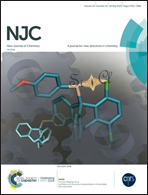Tuning the aggregation of an amphiphilic anionic calix[5]arene by selective host–guest interactions with bola-type dications†
Abstract
Nanosized supramolecular assemblies were observed in diluted solutions (below the cmc) of amphiphilic p-tert-butylcalix[5]arene penta-O-butylsulfonato 1 and in mixtures of 1 and bola-type α,ω-alkanediyldiammonium ions of different lengths. SEM analyses and light scattering experiments revealed that these dications are able to modulate the size and the superficial charge of the colloidal systems under investigation. Comparison with NMR data unveiled the nature of the host/guest recognition events taking place, disclosing the formation of supra-amphiphilic surfactant species. The stoichiometry of the calixarene/diammonium ion inclusion complexes was found to be strongly dependent on the length and the number of equivalents of the guest used. The selective formation of endo-cavity “supramolecular bola-amphiphiles” and the additional interplay of electrostatic/hydrophobic interactions yielded “NMR-visible” and “NMR-invisible” supramolecular assemblies of different natures. The supramolecular bola-amphiphile derived from 1 and the hexadecanediyldiammmonium ion was seen to act as a promising solubilising agent, by significantly increasing the solubility of anticancer drug tamoxifen in water (>1000 fold).
![Graphical abstract: Tuning the aggregation of an amphiphilic anionic calix[5]arene by selective host–guest interactions with bola-type dications](/en/Image/Get?imageInfo.ImageType=GA&imageInfo.ImageIdentifier.ManuscriptID=C9NJ01198F&imageInfo.ImageIdentifier.Year=2019)


 Please wait while we load your content...
Please wait while we load your content...